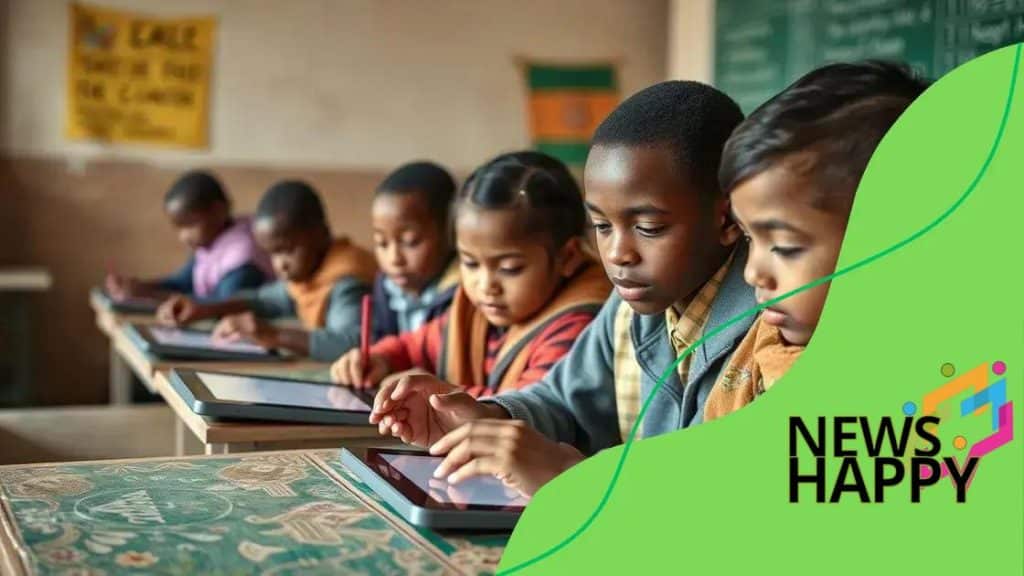How technology is bridging the education gap in rural areas

Anúncios
Technology is bridging the education gap in rural areas by providing online learning resources, enhancing access to education, and integrating innovative tools like AI and mobile technology to improve learning experiences for students.
How technology is bridging the education gap in rural areas shows us how digital tools can change lives. Have you considered how a simple tablet might impact a child’s education? Let’s explore this together.
Anúncios
Understanding the education gap in rural areas
Understanding the education gap in rural areas is crucial for creating effective solutions. Many students in these regions lack access to essential educational resources. This gap can create significant barriers to learning and development.
Factors Contributing to the Education Gap
Several reasons contribute to the education gap in rural areas. Understanding these factors can help us address them effectively.
- Limited access to technology and the internet
- Shortage of qualified teachers in remote locations
- Inadequate school infrastructure
- Economic barriers affecting families’ ability to support education
These challenges make it difficult for students to receive a quality education. For example, a lack of reliable internet can hinder students from accessing online learning materials. Similarly, without qualified teachers, students may struggle to grasp fundamental concepts.
Anúncios
The Impact on Students
The impact of the education gap on students is profound. Many students may fall behind their peers in urban areas. This disparity affects not only their academic performance but also their future opportunities. Imagine a student who dreams of becoming a doctor but cannot access the necessary resources to prepare for medical school.
Moreover, rural communities often lack the extracurricular programs that enhance learning. Sports, music, and clubs can play an essential role in youth development. Without these opportunities, students in rural areas may miss out on valuable experiences that help shape their futures.
Task Ahead
Addressing the education gap will require collaboration among various stakeholders. Schools, local governments, and non-profits must work together to create effective solutions. For instance, introducing mobile learning initiatives can help bridge the technological divide.
Additionally, community-driven programs that focus on teacher training can improve the quality of education. By investing in both technology and teachers, we can help ensure that students in rural areas receive the education they deserve. Through dedicated efforts, we can create a brighter future for these communities.
The role of online learning platforms
The role of online learning platforms is increasingly important in today’s education landscape. In rural areas, where traditional resources may be limited, these platforms offer innovative solutions to enhance learning.
Accessibility of Education
Online learning platforms provide access to quality educational material that many rural students might not otherwise have. These platforms can be accessed anytime and anywhere, bridging the gap for students who may live far from schools or lack adequate transportation.
- Students can learn at their own pace.
- Courses are often designed by expert educators.
- Resources are available in various formats like videos, articles, and quizzes.
- Flexibility allows learners to balance studies with family or work responsibilities.
As students engage with these resources, they become more motivated to learn. For example, interactive elements like quizzes and video discussions foster a more dynamic learning experience. This can make education feel more engaging and relevant.
Support for Teachers
Online learning platforms also support teachers by providing them with tools to enhance their teaching methods. Educators can use these platforms to create varied lesson plans and track student progress more effectively. This is particularly beneficial in rural areas where teachers might work with large class sizes.
By integrating technology, teachers can offer personalized learning experiences tailored to each student’s needs. Teachers are able to share resources such as assignments and feedback quickly, making communication more efficient.
Community and Collaboration
Furthermore, online platforms foster a sense of community among students and educators. Students can connect with peers from different regions, share experiences, and collaborate on projects. This encourages teamwork and critical thinking.
Participating in discussion boards or group projects online allows students to develop their communication skills and build relationships, which are essential for their future careers. Technology is indeed making a difference in how education is delivered and received.
Mobile technology enhancing rural education

Mobile technology is enhancing rural education in significant ways. With the widespread use of smartphones and tablets, students in remote areas can access learning resources that were previously unavailable.
Wider Access to Resources
Mobile devices allow students to connect to educational apps and websites easily. This means they can study anytime and anywhere, breaking down the barriers imposed by distance.
- Students can participate in online classes via mobile.
- Access to educational videos and tutorials is now just a click away.
- Interactive quizzes and learning games on mobile platforms can improve engagement.
- Educational resources can be downloaded for offline use, helping those with limited internet connectivity.
As students utilize these technologies, they experience a more personalized learning journey. For example, they can choose the subjects they want to focus on based on their interests and learning needs.
Supporting Teachers and Community
Mobile technology doesn’t just benefit students; it also supports teachers. Educators can share assignments and resources directly with students through mobile applications. This increases communication and feedback, which are crucial for effective learning.
Moreover, mobile technology enhances community involvement in education. Parents can engage with educational apps to track their children’s progress. This encourages a supportive learning environment at home. When families are involved, students often perform better academically.
The Future of Mobile Education
Looking ahead, mobile technology will likely play a crucial role in shaping the future of education in rural areas. Innovations such as augmented reality and virtual classrooms can create immersive learning experiences. These technologies can bridge the gap even further, making education more engaging and relevant.
As mobile technologies continue to evolve, their impact on rural education will grow. It’s exciting to think about the possibilities these tools can offer to students and teachers alike.
Community initiatives leveraging technology
Community initiatives are leveraging technology to enhance education in rural areas. These programs aim to bring together resources, support, and technology to create a better learning environment for students.
Collaboration Among Local Organizations
Local organizations often collaborate to meet educational needs in rural communities. This cooperation helps to pool resources and knowledge, making technology more accessible. For example, partnerships between schools, nonprofits, and tech companies can provide valuable tools and training.
- Workshops on using technology in the classroom.
- Funding for laptops and internet access.
- Community events to promote digital literacy.
- Volunteer programs to assist teachers in tech integration.
These initiatives not only improve education but also foster a sense of community. When people come together to support local education, it builds a network of encouragement and engagement.
Integrating Technology in Learning
Many community initiatives focus on integrating technology into the learning process. By utilizing online resources and educational platforms, students can enjoy a richer learning experience. Community mentors often help guide students in these learning environments.
Additionally, local libraries and community centers can become hubs for technology training. They can offer programs that teach students and parents how to use various educational tools effectively. This access helps bridge the digital divide.
Benefits of Community Engagement
Engaging the community in educational initiatives leads to numerous benefits. When families participate, they become more invested in their children’s education. This support reinforces the importance of learning and motivates students to excel.
Community initiatives also create a sustainable approach to education. By involving local resources and stakeholders, these programs can adapt to specific needs over time. Empowering communities to take charge of their educational initiatives is key to long-term success.
Future trends in rural education technology
Future trends in rural education technology are promising and hold great potential for transforming learning experiences. As technology continues to evolve, it will play a crucial role in addressing the challenges faced by rural students and educators.
Integration of Artificial Intelligence
One significant trend is the integration of artificial intelligence (AI) in educational tools. AI can help personalize learning by adapting content to meet individual student needs. For instance, AI-driven platforms can provide tailored feedback and recommendations, making education more effective.
- Smart tutoring systems that adjust to student performance.
- Data analysis to identify learning gaps.
- Automated grading systems for efficient feedback.
- Virtual learning assistants to enhance student support.
This technology can give rural students access to the same resources as those in urban areas, leveling the educational playing field.
Expanding Internet Connectivity
Another trend is the expansion of internet connectivity in rural regions. Reliable internet access is essential for educational success. As more initiatives focus on improving connectivity, students will be able to participate in online learning more effectively. Increased connectivity will enable:
- Access to vast online libraries and resources.
- Participation in remote learning programs and webinars.
- Collaboration with peers across different locations.
- Use of educational apps that require internet access.
With better connectivity, rural students can engage in more comprehensive learning experiences, fostering their academic growth.
Utilization of Virtual Reality
Virtual reality (VR) is also emerging as a transformative tool in rural education. This technology can provide immersive learning experiences that traditional classrooms cannot. For example, VR can transport students to historical sites or allow them to explore scientific concepts in a virtual environment.
Such experiential learning can make subjects like history and science more engaging. Rural students can benefit from these interactive experiences, enriching their understanding and sparking their interest in various fields.
Focus on Digital Literacy
Lastly, a strong emphasis on digital literacy is becoming increasingly important. Educators are recognizing that students need to be proficient in technology to succeed in today’s world. Programs that teach students how to use technology effectively will become a key component of rural education.
By focusing on digital skills, students will be better prepared for higher education and the workforce, further contributing to their success.
FAQ – Frequently Asked Questions about Bridging the Education Gap in Rural Areas
How does technology improve access to education in rural areas?
Technology provides rural students with access to online learning resources, helping them overcome geographical barriers.
What role do community initiatives play in education?
Community initiatives foster collaboration among local organizations, enabling better support and resources for education.
What future technologies can impact rural education?
Future technologies like AI and virtual reality can enhance learning experiences and make quality education more engaging.
Why is digital literacy important for rural students?
Digital literacy equips students with the skills needed to navigate technology, increasing their chances for future success in higher education and employment.





